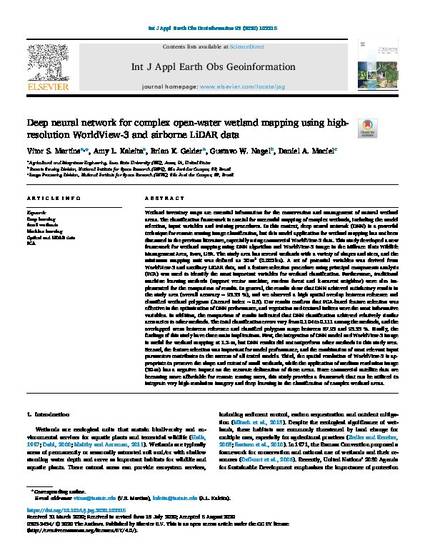
Wetland inventory maps are essential information for the conservation and management of natural wetland areas. The classification framework is crucial for successful mapping of complex wetlands, including the model selection, input variables and training procedures. In this context, deep neural network (DNN) is a powerful technique for remote sensing image classification, but this model application for wetland mapping has not been discussed in the previous literature, especially using commercial WorldView-3 data. This study developed a new framework for wetland mapping using DNN algorithm and WorldView-3 image in the Millrace Flats Wildlife Management Area, Iowa, USA. The study area has several wetlands with a variety of shapes and sizes, and the minimum mapping unit was defined as 20 m2 (0.002 ha). A set of potential variables was derived from WorldView-3 and auxiliary LiDAR data, and a feature selection procedure using principal components analysis (PCA) was used to identify the most important variables for wetland classification. Furthermore, traditional machine learning methods (support vector machine, random forest and k-nearest neighbor) were also implemented for the comparison of results. In general, the results show that DNN achieved satisfactory results in the study area (overall accuracy = 93.33 %), and we observed a high spatial overlap between reference and classified wetland polygons (Jaccard index ∼0.8). Our results confirm that PCA-based feature selection was effective in the optimization of DNN performance, and vegetation and textural indices were the most informative variables. In addition, the comparison of results indicated that DNN classification achieved relatively similar accuracies to other methods. The total classification errors vary from 0.104 to 0.111 among the methods, and the overlapped areas between reference and classified polygons range between 87.93 and 93.33 %. Finally, the findings of this study have three main implications. First, the integration of DNN model and WorldView-3 image is useful for wetland mapping at 1.2-m, but DNN results did not outperform other methods in this study area. Second, the feature selection was important for model performance, and the combination of most relevant input parameters contributes to the success of all tested models. Third, the spatial resolution of WorldView-3 is appropriate to preserve the shape and extent of small wetlands, while the application of medium resolution image (30-m) has a negative impact on the accurate delineation of these areas. Since commercial satellite data are becoming more affordable for remote sensing users, this study provides a framework that can be utilized to integrate very high-resolution imagery and deep learning in the classification of complex wetland areas.
Available at: http://works.bepress.com/amy_kaleita/74/

This article is published as Martins, Vitor S., Amy L. Kaleita, Brian K. Gelder, Gustavo W. Nagel, and Daniel A. Maciel. "Deep neural network for complex open-water wetland mapping using high-resolution WorldView-3 and airborne LiDAR data." International Journal of Applied Earth Observation and Geoinformation 93 (2020): 102215. DOI: 10.1016/j.jag.2020.102215. Posted with permission.